ENGLISH GRAMMAR SYNTAX. LECTURE 1 The

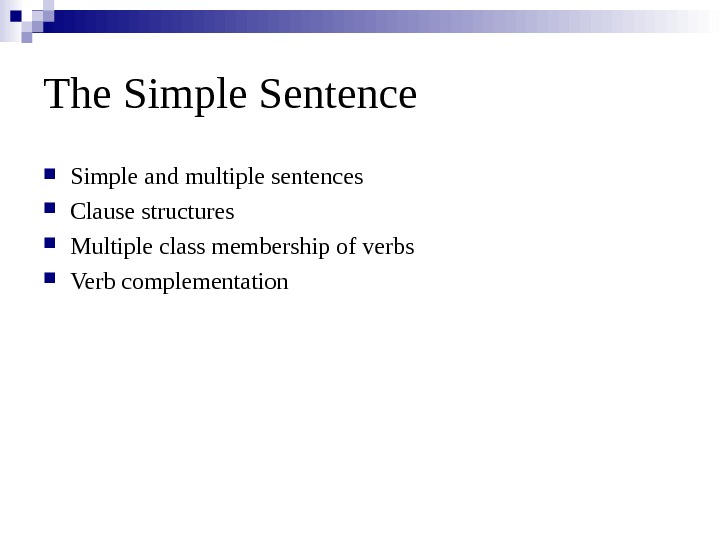
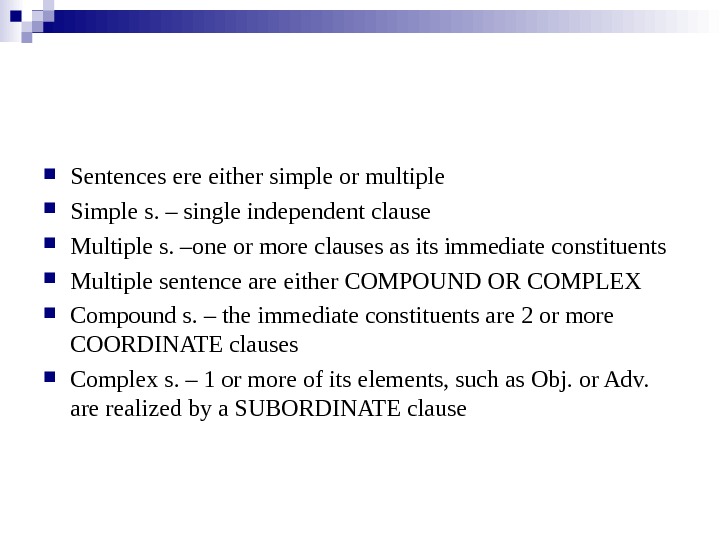
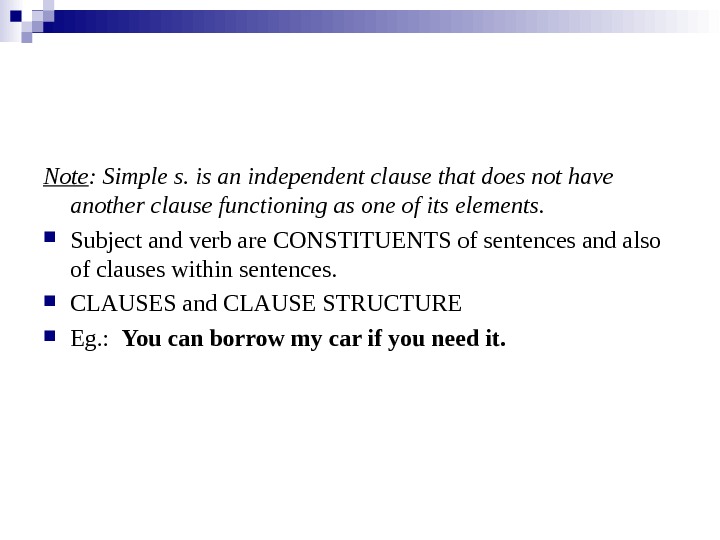
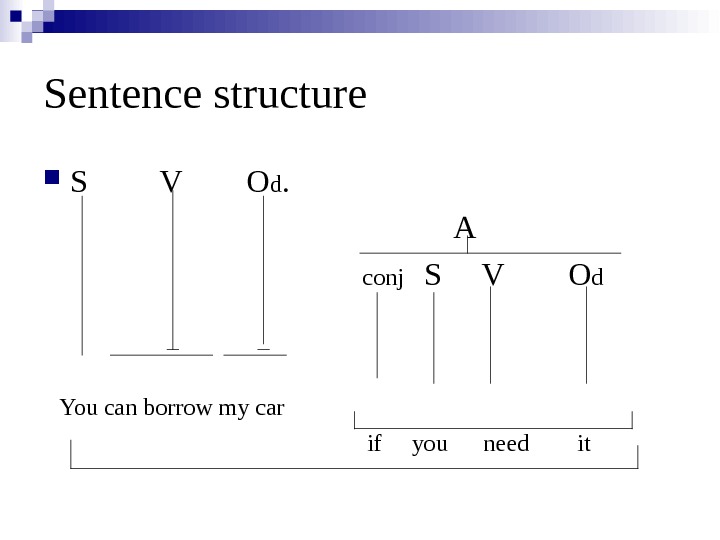
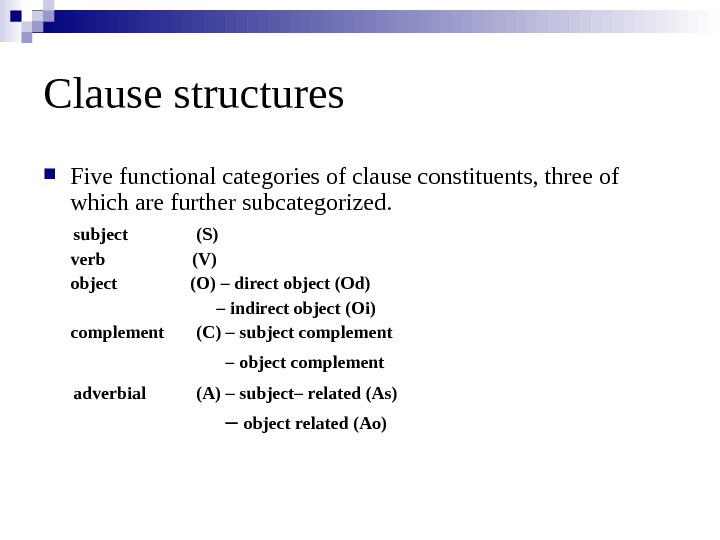
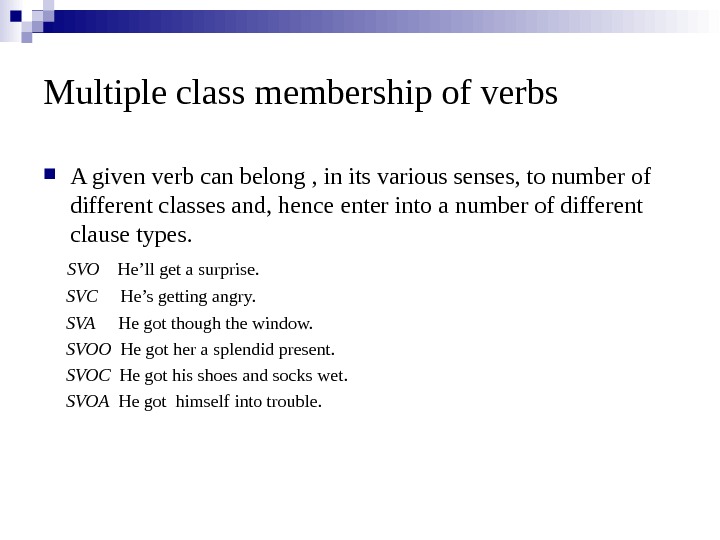
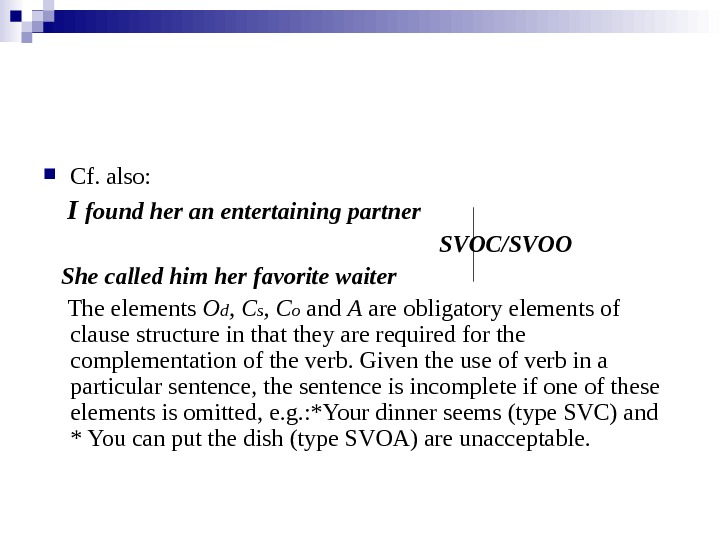
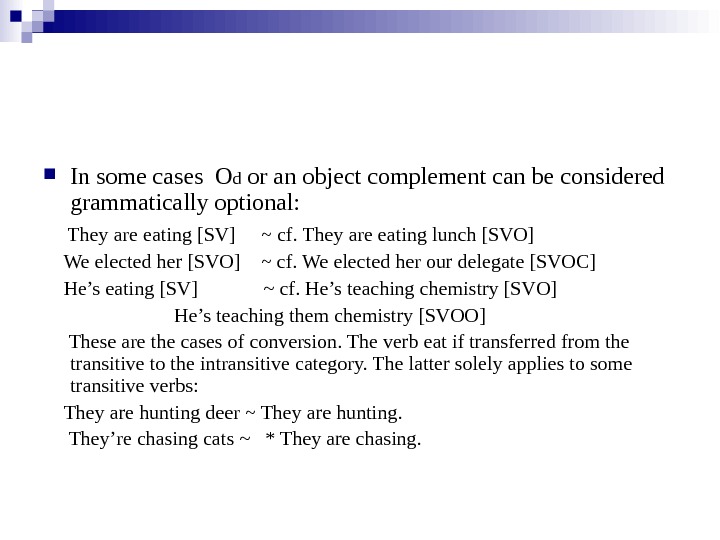
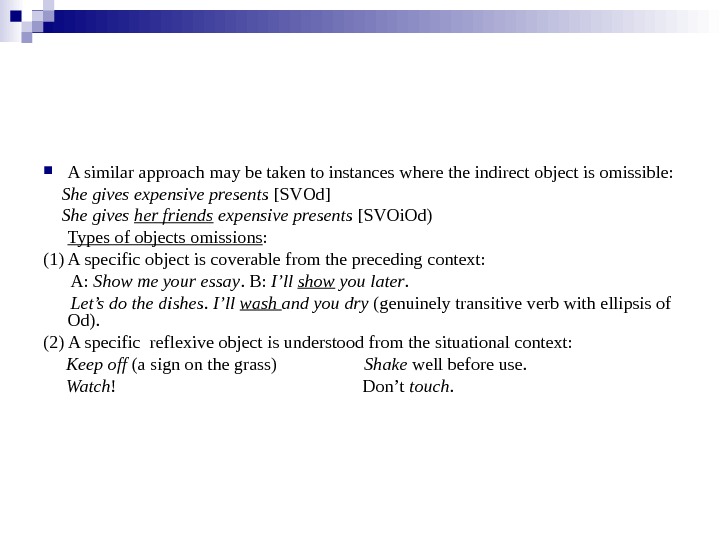
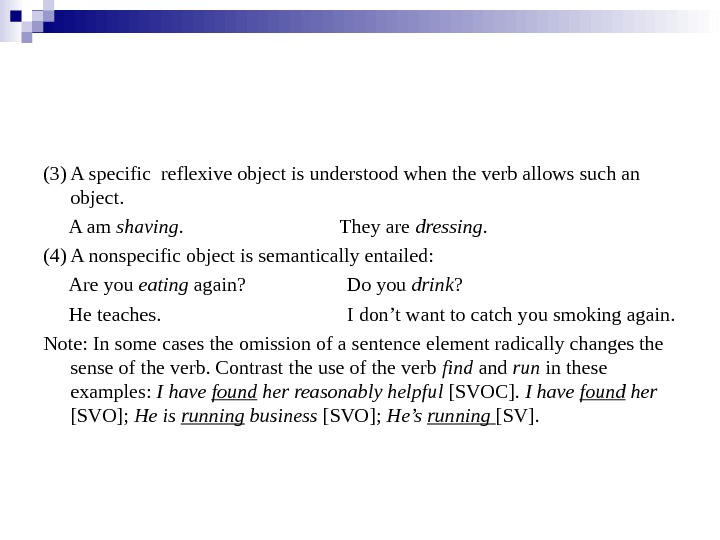
- Размер: 184 Кб
- Количество слайдов: 11
Описание презентации ENGLISH GRAMMAR SYNTAX. LECTURE 1 The по слайдам
 ENGLISH GRAMMAR SYNTAX. LECTUR
ENGLISH GRAMMAR SYNTAX. LECTUR
 The Simple Sentence Simple and multiple sentences Clause structures Multiple class membership of verbs Verb complementation
The Simple Sentence Simple and multiple sentences Clause structures Multiple class membership of verbs Verb complementation
 Sentences ere either simple or multiple Simple s. – single independent clause Multiple s. –one or more clauses as its immediate constituents Multiple sentence are either COMPOUND OR COMPLEX Compound s. – the immediate constituents are 2 or more COORDINATE clauses Complex s. – 1 or more of its elements, such as Obj. or Adv. are realized by a SUBORDINATE clause
Sentences ere either simple or multiple Simple s. – single independent clause Multiple s. –one or more clauses as its immediate constituents Multiple sentence are either COMPOUND OR COMPLEX Compound s. – the immediate constituents are 2 or more COORDINATE clauses Complex s. – 1 or more of its elements, such as Obj. or Adv. are realized by a SUBORDINATE clause
 Note : Simple s. is an independent clause that does not have another clause functioning as one of its elements. Subject and verb are CONSTITUENTS of sentences and also of clauses within sentences. CLAUSES and CLAUSE STRUCTURE Eg. : You can borrow my car if you need it.
Note : Simple s. is an independent clause that does not have another clause functioning as one of its elements. Subject and verb are CONSTITUENTS of sentences and also of clauses within sentences. CLAUSES and CLAUSE STRUCTURE Eg. : You can borrow my car if you need it.
 Sentence structure S V O d. A conj S V O d You can borrow my car if you need it
Sentence structure S V O d. A conj S V O d You can borrow my car if you need it
 Clause structures Five functional categories of clause constituents, three of which are further subcategorized. subject (S) verb (V) object (O) – direct object (Od) – indirect object (Oi) complement (C) – subject complement – object complement adverbial (A) – subject– related (As) – object related (Ao)
Clause structures Five functional categories of clause constituents, three of which are further subcategorized. subject (S) verb (V) object (O) – direct object (Od) – indirect object (Oi) complement (C) – subject complement – object complement adverbial (A) – subject– related (As) – object related (Ao)
 Multiple class membership of verbs A given verb can belong , in its various senses, to number of different classes and, hence enter into a number of different clause types. SVO He’ll get a surprise. SVC He’s getting angry. SVA He got though the window. SVOO He got her a splendid present. SVOC He got his shoes and socks wet. SVOA He got himself into trouble.
Multiple class membership of verbs A given verb can belong , in its various senses, to number of different classes and, hence enter into a number of different clause types. SVO He’ll get a surprise. SVC He’s getting angry. SVA He got though the window. SVOO He got her a splendid present. SVOC He got his shoes and socks wet. SVOA He got himself into trouble.
 Cf. also: I found her an entertaining partner SVOC/SVOO She called him her favorite waiter The elements O d , C s , C o and A are obligatory elements of clause structure in that they are required for the complementation of the verb. Given the use of verb in a particular sentence, the sentence is incomplete if one of these elements is omitted, e. g. : *Your dinner seems (type SVC) and * You can put the dish (type SVOA) are unacceptable.
Cf. also: I found her an entertaining partner SVOC/SVOO She called him her favorite waiter The elements O d , C s , C o and A are obligatory elements of clause structure in that they are required for the complementation of the verb. Given the use of verb in a particular sentence, the sentence is incomplete if one of these elements is omitted, e. g. : *Your dinner seems (type SVC) and * You can put the dish (type SVOA) are unacceptable.
 In some cases O d or an object complement can be considered grammatically optional: They are eating [SV] ~ cf. They are eating lunch [SVO] We elected her [SVO] ~ cf. We elected her our delegate [SVOC] He’s eating [SV] ~ cf. He’s teaching chemistry [SVO] He’s teaching them chemistry [SVOO] These are the cases of conversion. The verb eat if transferred from the transitive to the intransitive category. The latter solely applies to some transitive verbs: They are hunting deer ~ They are hunting. They’re chasing cats ~ * They are chasing.
In some cases O d or an object complement can be considered grammatically optional: They are eating [SV] ~ cf. They are eating lunch [SVO] We elected her [SVO] ~ cf. We elected her our delegate [SVOC] He’s eating [SV] ~ cf. He’s teaching chemistry [SVO] He’s teaching them chemistry [SVOO] These are the cases of conversion. The verb eat if transferred from the transitive to the intransitive category. The latter solely applies to some transitive verbs: They are hunting deer ~ They are hunting. They’re chasing cats ~ * They are chasing.
 A similar approach may be taken to instances where the indirect object is omissible: She gives expensive presents [SVOd] She gives her friends expensive presents [SVOi. Od) Types of objects omissions : (1) A specific object is coverable from the preceding context: A: Show me your essay. B: I’ll show you later. Let’s do the dishes. I’ll wash and you dry (genuinely transitive verb with ellipsis of Od). (2) A specific reflexive object is understood from the situational context: Keep off (a sign on the grass) Shake well before use. Watch ! Don’t touch.
A similar approach may be taken to instances where the indirect object is omissible: She gives expensive presents [SVOd] She gives her friends expensive presents [SVOi. Od) Types of objects omissions : (1) A specific object is coverable from the preceding context: A: Show me your essay. B: I’ll show you later. Let’s do the dishes. I’ll wash and you dry (genuinely transitive verb with ellipsis of Od). (2) A specific reflexive object is understood from the situational context: Keep off (a sign on the grass) Shake well before use. Watch ! Don’t touch.
 (3) A specific reflexive object is understood when the verb allows such an object. A am shaving. They are dressing. (4) A nonspecific object is semantically entailed: Are you eating again? Do you drink ? He teaches. I don’t want to catch you smoking again. Note: In some cases the omission of a sentence element radically changes the sense of the verb. Contrast the use of the verb find and run in these examples: I have found her reasonably helpful [SVOC]. I have found her [SVO]; He is running business [SVO]; He’s running [SV].
(3) A specific reflexive object is understood when the verb allows such an object. A am shaving. They are dressing. (4) A nonspecific object is semantically entailed: Are you eating again? Do you drink ? He teaches. I don’t want to catch you smoking again. Note: In some cases the omission of a sentence element radically changes the sense of the verb. Contrast the use of the verb find and run in these examples: I have found her reasonably helpful [SVOC]. I have found her [SVO]; He is running business [SVO]; He’s running [SV].
